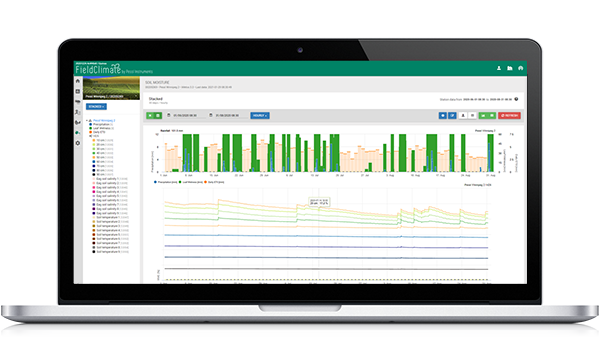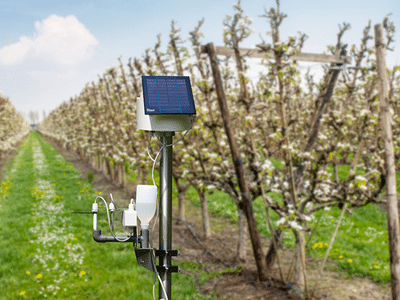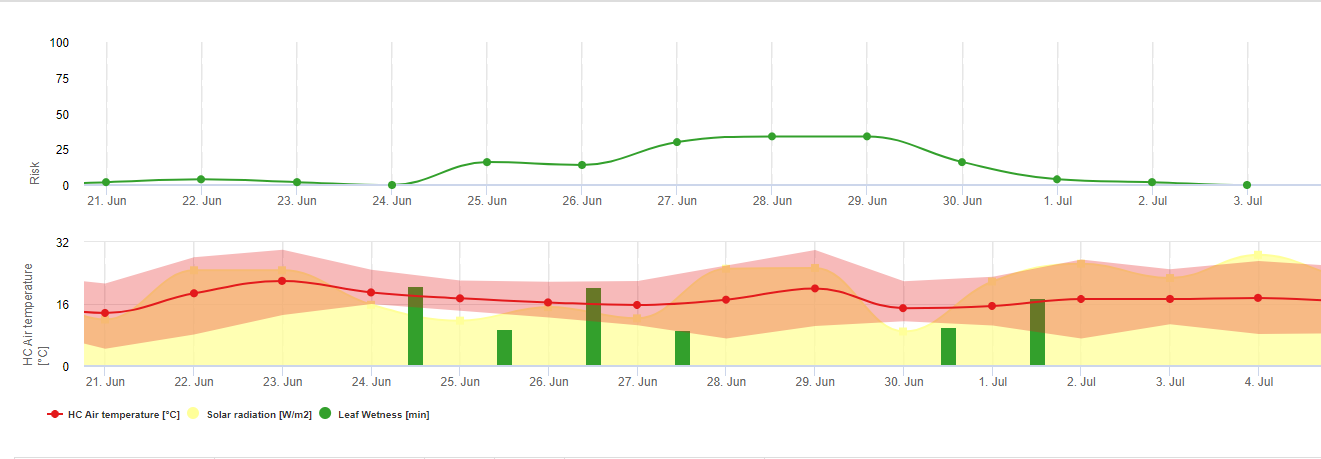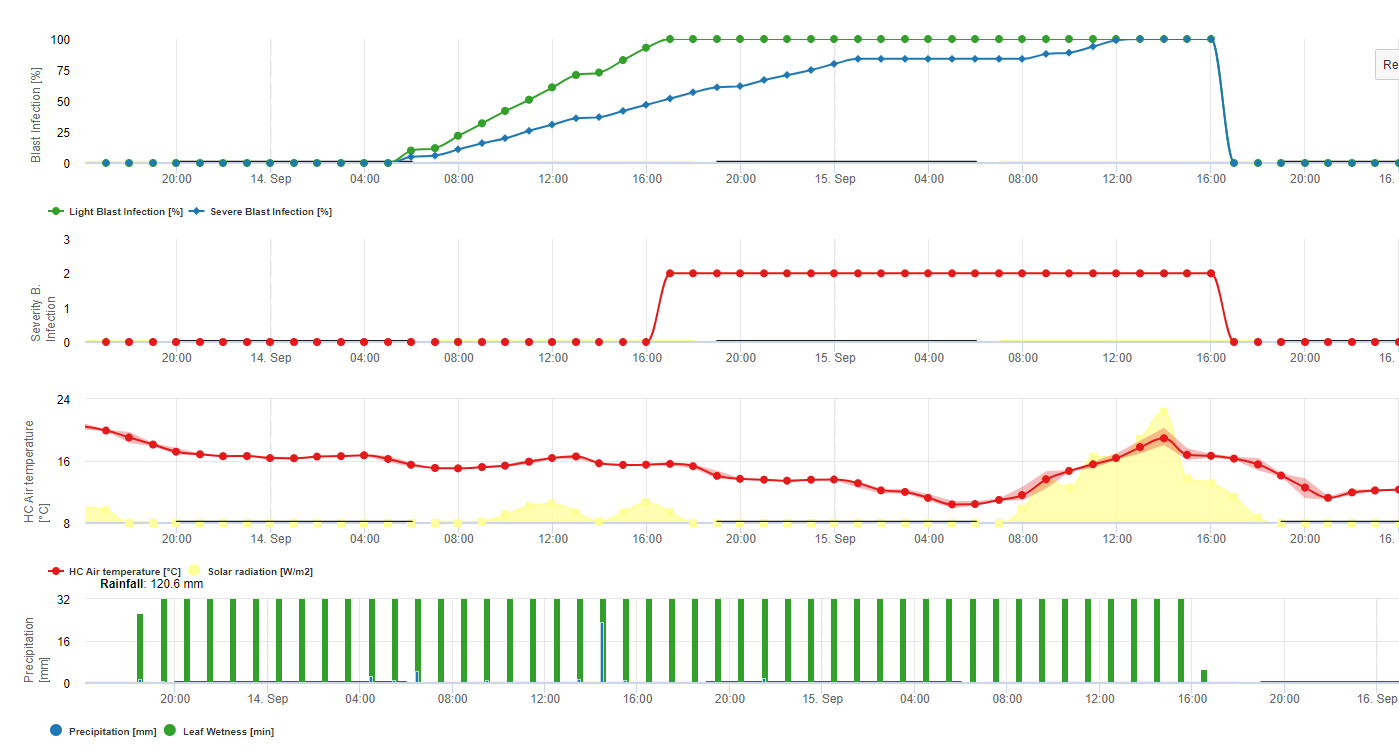

Rice disease models
Sheath Blight
Sheath Blight (fungus – Rhizoctonia solani): Sheath blight is a major disease of the rice plant. Initial symptoms usually develop as lesions on sheaths of lower leaves near the water line when plants are in the late tillering or early internode elongation stage of growth (approximately 10 – 15 days after flooding). These lesions usually develop just below the leaf collar as oval-to-elliptical, green-grey, water-soaked spots about 1/4 inch wide and 1/2 to 1 1/4 inch long.
With age, the lesions expand and the centre of the lesions may become bleached with an irregular tan-to-brown border. When humidity exceeds 95 per cent and temperatures are in the range of 85-90 degrees F (30-32°C), the infection spreads rapidly by means of runner hyphae to upper plant parts, including leaf blades, causing extensive, tan, irregularly shaped lesions with brown borders. Disease development progresses very rapidly in the early heading and grain filling growth stages during periods of frequent rainfall and overcast skies. Plants heavily infected at these stages produce poorly filled grain, particularly in the lower portion of the panicle. Additional losses result from increased lodging or reduced ratoon production due to infection of the culm and reduced carbohydrate reserves.
As plants senesce from maturity, lesions will dry and become greyish-white to tan with brownish borders. Sclerotia, initially white but turning dark brown at maturity, are produced superficially on or near the lesions. Sclerotia are loosely attached and easily dislodge from the plant. Sclerotia are the primary means for fungus survival between crops. They survive long periods in the soil and will float to the surface of flooded rice fields in the subsequent rice crop, infect rice plants at the waterline and continue the disease cycle. Sclerotia can survive from one to several years in the soil. They can also attack several weed hosts and cause infection.
New varieties and changing cultural practices often combine many of the factors that favour disease development. In recent years, the wide acceptance of susceptible varieties, because of their high yielding potential, has contributed greatly to the rapid increase in sheath blight. In addition, the new varieties respond to heavy nitrogen applications in order to achieve their high-yielding potential. Heavy applications of nitrogen predispose susceptible plants to attack by the sheath blight organism. Rotation with susceptible crops, such as soybean (see Soybean Aerial Blight) can also increase the severity of sheath blight in succeeding rice crops.
Disease incidence may be reduced by planting less susceptible varieties. Excessive seeding rates and high nitrogen applications should be avoided in fields with a history of the disease. Grass and weeds should be controlled. Long-term rotations may reduce the incidence of sheath blight, but soybeans, sorghum, and many weeds are susceptible to Rhizoctonia solani. Excessive seeding rates and thick plant populations favour sheath blight development. In some cases, foliar fungicides may be economical for reducing sheath blight losses.
Rhizoctonia solani – fungal biology
The disease is soilborn. It usually starts at the base of the plant near the water level. Later, the symptoms are observed on the upper leaf sheath and on the leaf blade. The disease usually infects the plant at late tillering or early internode elongation growth stages. The disease may spread from one hill to another through leaf-to-leaf or leaf-to-sheath contacts.
It is commonly assumed that the critical factors for disease development are relative humidity and temperature. Relative humidity ranging from 96 to 100% and temperature ranging from 28-32°C have been reported to favour the disease. A high supply of nitrogen fertilizer, and growing of high-yielding, high-tillering, nitrogen-responsive improved varieties favour the development of the disease. High leaf wetness and high frequency of tissue contacts among plants also favour the disease.
The pathogen can be spread through irrigation water and by the movement of soil and infected crop residues during land preparation. The young mycelium of the fungus is colourless. With age, it turns yellowish to brown and measures 8-12 µm in diameter with infrequent septations. There are three types of mycelium produced: runner hyphae, lobate hyphae, and monilioid cells. The runner hyphae have thick, parallel walls and spread rapidly over the sheath and leaf surfaces of the rice plant. The runner hyphae give rise to lobate hyphae or appressoria. Monilioid cells are short, broad cells involved in the formation of sclerotia.
Sclerotia consist of compact masses of mycelia. They are irregular, hemispherical, flattened at the bottom, white when young, and turn brown or dark brown when older. Individual sclerotia are 1-6 mm in diameter. They may unite to form a larger mass. Large sclerotia are significantly more virulent than smaller ones. The sclerotia germinate and initiate infection once they get in contact with the rice plant. The fungus penetrates through the cuticle or the stomata slit. Infection pegs are formed from each lobe of the lobate appressorium of the infection cushion. The mycelium grows from the outer surface of the sheath going through the sheath edge and finally through the inner surface. Primary lesions are formed while the mycelium grows rapidly on the surface of the plant tissue and inside its tissue. It proceeds upwards and laterally to initiate the formation of the secondary lesions. The disease starts during the maximum growth stage of the rice crop. Under favourable conditions, the disease increases as the plant grow older. The damage caused by the disease depends on the infection of the plants at plant growth stages.
Sheath Blight Disease Model
The model of R. solani in rice fields is evaluating the risk for this disease on the base of temperature, leaf wetness and global radiation.
It checks last 120 hours:
– In case of consecutive leaf wetness it accumulates temperature depending on values for every minute.
• 12 °C to 15 °C it accumulates 1 per minute
• 16 °C to 17 °C it accumulates 2 per minute
• 18°C and more it accumulates 4 per minute
– At the end of the leaf wetness periods it evaluates the accumulated values
• if the residual is greater than 2048 it increases the risk by 16 and subtracts 2048 from the value
• if the residual is greater than 1024 it increases the risk by 4 and subtracts 1024 from the value
– If global radiation is consecutive higher than 800 W/m² accumulate time in minutes and if radiation becomes lower evaluate values:
• Value > 512 = RiskValue – 32 Points , Value – 512
• Value > 256 = RiskValue – 8 Points , Value – 256
• Value >128= RisKValue – 2 Points, Value -128
The model results in a risk value between 0 and 100 indicating the times favourable for R. solani in rice fields.
Support System
The sheath blight model points out periods with a high risk for this disease. No sprays will have to be applied in periods where the risk is low. In periods with moderate risk, spray interval can be prolongated and in periods with high-risk spray interval may have to be reduced or more effective compounds will have to be used.
Rice Blast
Magnaporthe grisea, also known as Rice Blast fungus, Rice Rotten neck, Rice Seedling blight, Blast of rice, oval leaf spot of Graminea, pitting disease, ryegrass blast, and johnson spot, is a plant-pathogenic fungus that causes an important disease affecting rice. It can also infect a number of other agriculturally important cereals including wheat, rye, barley, and pearl millet causing diseases called blast disease or blight disease. M. grisea causes economically significant crop losses annually, each year it is estimated to destroy enough rice to feed more than 60 million people. The fungus is known to occur in 85 countries worldwide. It is sometimes thought of as a model organism in the study of phytopathogenic fungi.
Rice Blast Model
The Rice Blast Infection model points out the date time and severity of infection. Light infections finish faster than severe infections. For severe infections, it will need higher temperatures and longer leaf wetness periods. The severity of infection is rated by the possibility of light or a severe infection and the amount of rain at the initial of the infection. Higher rain amounts with higher intensities will lead to a better distribution of spores. The model goes back to the publications of Yoshino 1974, 1979 and Hashimoto et al 1984.
The infection starts with rain smaller than 4 mm and leaf wetness. The infection progresses in dependence on temperature. The graphs below is showing the relation between temperature and leaf wetness period to fulfil a light (level 1) and a severe (level 2) infection. On the base of these curves, the model indicates the possibility of infection by this disease. If the disease progress curve reaches 100% the light or severe infection is finished and symptoms are expected after 4 to 5 days.
The severity depends on temperature during infection and on precipitation. The graph shows a relation between severity and temperature during infection.
The rice blast model points out infection date and infection severity. This information is valid to improve the applied spray program. In a preventative spray program plant growth is reducing the protected plant surface within days. An infection which takes place immediately after a preventative spray will be covered perfectly. If an infection will be 6 or more days after the last spray disease control can be sustainable reduced by the high volume of uncovered leaves. In this case a curative spray will be indicated to ensure the success of disease control.
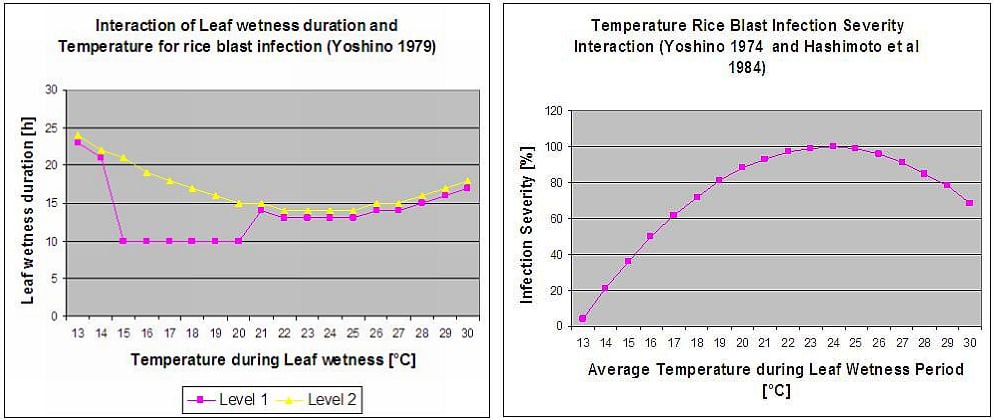

Recommended equipment
Check which sensor set is needed for monitoring this crop’s potential diseases.

